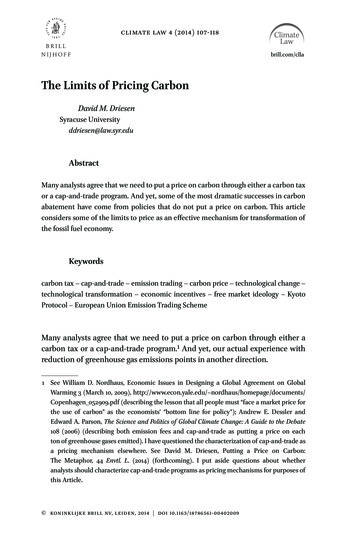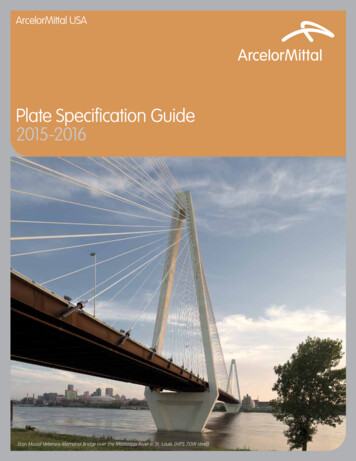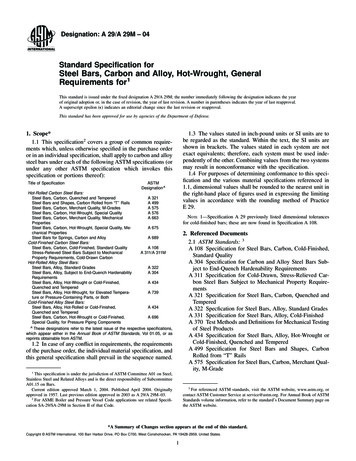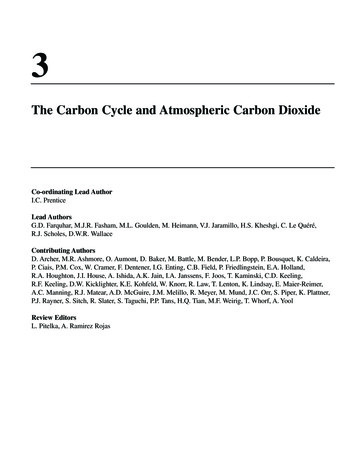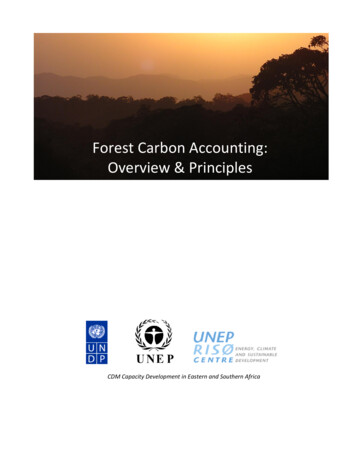
Transcription
Forest Carbon Accounting:Overview & PrinciplesCDM Capacity Development in Eastern and Southern Africa
Charlene WatsonLondon School of Economics and Political Sciencec.watson2@lse.ac.ukDisclaimerThe views expressed in this publication are those of the author and do not necessarily represent those of theUnited Nations, UNDP, UNEP, UNEP Risoe Centre or their Member States.1
Forest Carbon Accounting: Overview & PrinciplesExecutive SummaryForests play an important role in the global carbon balance. As both carbon sources and sinks, theyhave the potential to form an important component in efforts to combat global climate change.Accounting for the carbon within forest ecosystems and changes in carbon stocks resulting fromhuman activities is a necessary first step towards the better representation of forests in climatechange policy at regional, national and global scales.The United Nations Development Programme (UNDP), as part of the UNDP-UNEP CDM CapacityDevelopment Project for Eastern & Southern Africa, is seeking to promote carbon projects in subSaharan Africa, in the important bio-carbon sector and others. This report reinforces UNDP’s capacitybuilding efforts by presenting the main principles, practices and challenges of carbon accounting inthe forestry sector.Forest carbon accounting can be divided into three forms. Stock accounting assesses the magnitudeof carbon stored in forest ecosystems at a single point in time. Emissions accounting assesses the netgreenhouse gas emissions to the atmosphere resulting from forests. Emission reductions accountingassesses the decrease in emissions from project or policy activities, often so that they can be traded.Forest carbon accounting identifies the carbon-density of areas, providing information for lowcarbon-impact land use planning. It prepares territories for accounting and reporting of emissionsfrom the forestry sector. It allows comparison of the climate change impact of the forestry sectorrelative to other sectors, as well as allowing comparison between territories. Finally, it enables tradeof project emission reductions on carbon markets and for emission reductions to be included in policytargets.Good practice in forest carbon accounting must be adhered to. In particular, transparency in methodsand accuracy and precision in accounting are required for public and political acceptance of resultantestimates. A basic knowledge of the principles underlying forest carbon accounting is also beneficial.Understanding biomass dynamics and flows between carbon pools in forest ecosystems enables moreeffective accounting.The practice of forest carbon accounting requires clear identification of the accounting boundary inboth space and time. Stratifying the forest into areas with similar carbon characteristics furtherimproves the accuracy of carbon accounting. Data for accounting can be gathered from a variety ofsources, including existing secondary data, remotely sensed data and primary data through fieldsurveys. The amount of data from each source depends on the quality of the source as well as thetrade-offs that must be made between accounting accuracy and costs of resources and time.All forest carbon accounting estimates contain uncertainty. Practitioners should identify, minimisewhere possible, and quantify this uncertainty through statistical analysis, published information andexpert judgement. Uncertainty of model variables and components, once quantified, can beaggregated through simple propagation of errors or simulated through Monte Carlo analysis. Theexistence of substantial uncertainty can undermine efforts to reduce carbon emissions from forestryand can erode political support for the accounting process.2
Forest carbon accounting guidance from the Intergovernmental Panel on Climate Change (IPCC) hasbecome the primary source of information for methods, accounting equations and parameters.However, IPCC guidance is vast and often difficult to navigate. In response, a number of tools forforest carbon accounting have emerged. These vary in terms of geographical coverage, forestryactivities and the carbon pools accounted for, as well as the level of data input required. In light ofsuch diversity, practitioners require an understanding of the forest carbon accounting process,irrespective of whether these tools are utilised.Despite substantial progress in the field of forest carbon accounting over the last decade, challengesstill remain. Terminology relating to forests and managed lands is ambiguous and requiresstandardisation between stakeholders. More scientific research into forest biomass characteristics isalso required to better incorporate the heterogeneity of forests, their growth dynamics and the fateof carbon in harvested wood products into forest carbon accounting methods.Forest carbon accounting is a multi-disciplinary task. Building capacity is essential. Investment is alsonecessary to improve and standardise carbon accounting methods. If future climate change policy andstrategy are to adequately reflect the substantial role forests play in the global carbon balance, goodforest carbon accounting is imperative.3
Table of ContentsExecutive Summary .2List of Figures .51. Introduction .61.1. Report structure .61.2. What is forest carbon accounting? .62. Principles of forest carbon accounting.72.1. Accounting good practice .72.2. Biomass, carbon pools and stock accounting .82.3. Approaches to emission accounting . 102.4. Accounting for emission reductions . 112.4.1. Baselines . 122.4.2. Additionality. 122.4.3. Leakage . 132.4.4. Permanence . 133. Practice of forest carbon accounting . 143.1. Establishing the accounting area . 143.2.1. Collating existing forest data . 163.2.2. Using remote sensing . 163.2.3. Data from field sampling . 183.3. Accounting for forest carbon stocks . 183.3.1. Above-ground biomass (AGB) . 183.3.2. Below-ground biomass (BGB) . 193.3.3. Dead organic matter (wood). 203.3.4. Dead organic matter (litter) . 203.3.5. Soil organic matter (SOM) . 203.4. Accounting for forest carbon emissions . 213.4.1. Accounting for carbon stock changes in carbon pools. 213.4.2. Accounting for carbon stored in harvested wood products (HWPs) . 213.4.3. Accounting for nitrous oxide and methane emissions from disturbances . 223.5. Quantifying uncertainty in carbon accounting . 234. Guidance and tools for forest carbon accounting . 244.1. IPCC guidelines . 244.2. Carbon accounting tools. 254.3. Bilan Carbone . 265. Challenges for forest carbon accounting . 265.1. Clarifying terminology . 265.1.1. Definition of ‘forest’ . 265.1.2. Direct human-induced impacts . 275.2. Forest Characteristics . 285.2.1. Heterogeneity of forests . 285.2.2. Forest growth and equilibrium . 295.2.3. Accounting for harvested wood products . 296. Conclusion . 307. Appendices . 317.1. Appendix I: References . 317.2. Appendix II: Acronyms . 367.3. Appendix III: Glossary. 377.4. Appendix IV: Examples of default equations and data for forest carbon accounting . 394
List of TablesTable 1. Good practice for forest carbon accounting .8Table 2. Default forest biomass and annual biomass increment under tier 1 IPCC guidance . 17Table 3. Factors affecting forest carbon stocks . 28Table A4:1. Exemplary above-ground biomass regression equations for tropical trees . 39Table A4:2. Default mineral soil organic carbon stocks . 39List of FiguresFigure 1. Diagrammatic Representation of Carbon Pools . 9Figure 2. Generalised flow of carbon between pools . 10Figure 3. Outline of the practice of forest carbon accounting . 155
1. Introduction1.1. Report structureThere has been considerable and growing interest in forest carbon and its role in international climatechange policy. This interest stems from the substantial greenhouse gas (GHG) emissions that arisefrom the forestry sector and the potential for forests to deliver cheap-and-deep emission reductions.Forest Carbon Accounting: Overview & Principles presents the main principles, practices andchallenges for carbon accounting in the forestry sector. In order to be accessible, the report is notoverly technical and should not, therefore, be considered a stand-alone guide for forestry carbonaccounting. It does, however, present guidance for good practice in accounting and indicates furthersources of guidance. Section 1 outlines the historic, current and future needs for forest carbonaccounting. Section 2 focuses on principles and good practice. The process of forest carbonaccounting is outlined in Section 3. Section 4 highlights existing guidance and toolkits available forforestry carbon accounting and Section 5 presents the challenges and limitations to date. Section 6concludes.Section 1:Section 2:Section 3:Section 4:Section 5:Section 6:What it is and whywe need itPrinciples andgood practiceThe process ofaccountingExisting toolsand modelsChallenges andlimitationsConcludingremarks1.2. What is forest carbon accounting?Carbon accounting is the practice of making scientifically robust and verifiable measurements of GHGemissions. Although characteristics of forests have been recorded for numerous historical purposes,accounting for carbon is a more recent addition to forest inventories. This follows the growing needto quantify the stocks, sources and sinks of carbon and other GHGs in the context of anthropogenicimpacts on the global climate.Historically, forest inventories recorded stand structure, age, growth rate, biomass accumulation, andthe wood densities of tree species. These have served both commercial purposes, such asdetermining merchantable timber volumes and use in the paper and pulp industry, as well as nationalor regional planning purposes, such as creating forest and land use inventories for land-use permits,land-use plans and agricultural expansion.In 1946, the Food and Agriculture Organisation (FAO) established the Forest Resource Assessment(FRA) which, published every five to ten years, compiles data gathered through national statistics andcountry-level reporting processes. Although criticised (see Grainger, 2008; Houghton, 2005), the FRAstill provides the most comprehensive assessment of global forest cover, management and trends todate. In combination with the substantial body of forest science research literature, the FRA andsimilar forest inventories provide the background for carbon accounting.The forestry sector plays a vital role in the global balance of GHGs. Deforestation alone accounts forapproximately 20% of anthropogenic emissions (FAO 2006; Stern, 2006) and the forestry sectorrepresents upwards of 50% of global greenhouse gas mitigation potential (IPCC, 2007). As forests rise6
up the climate change agenda, three types of forest carbon accounting have developed: stockaccounting, emissions accounting and project emission reductions accounting. Stock accountingForest carbon stock accounting often forms a starting point for emissions and projectlevel accounting. Establishing the terrestrial carbon stock of a territory and averagecarbon stocks for particular land uses, stock accounting allows carbon-dense areas to beprioritised in regional land use planning. An early form of forest carbon accounting,emissions and emission reductions accounting have evolved from the principlesestablished for stock accounting. Emissions accountingEmissions accounting is necessary to assess the scale of emissions from the forestrysector relative to other sectors. It also aids realistic goal-setting for GHG emissionstargets. Under the United Nations Framework Convention on Climate Change (UNFCCC)and the Kyoto Protocol, countries are mandated to undertake some land use, land usechange and forestry (LULUCF) carbon accounting (see Box 1). With a significant portionof developing country emissions arising from the LULUCF sector, the forestry sector islikely to play a prominent role in climate change strategies in these countries. Project emission reductions accountingCarbon accounting for forestry project emission reductions is required for both projectsundertaken under the flexible mechanisms of the Kyoto Protocol and the voluntarycarbon markets. Both necessitate good carbon accounting to ensure that emissionsreductions are real, permanent and verifiable. For projects to generate tradableemission reductions, accounting methods between countries, regions and projectsmust be standardised in both developed and developing countries.Past forest inventories and research outputs provide a substantial source of information on forestbiomass characteristics. The challenge is to translate this information into carbon estimates, inparticular increasing the coverage and/or scaling-up research that often focuses on ecological zonesor specific territories. Ultimately, the quality of forest carbon estimates will be governed by a numberof factors, not least time and financial resource constraints. Acknowledging that trade-offs betweenfactors in the accounting process are inevitable, the carbon accounting process must adhere to goodpractice guidance if forestry is to be adopted more comprehensively in climate change policy.2. Principles of forest carbon accounting2.1. Accounting good practiceRegardless of the type of accounting – stock, emissions or project emission reductions – there are anumber of principles for carbon accounting that should be followed (see Table 1). Adherence to goodpractice promotes better understanding, legitimacy and trust in the accounting system, which iscritical for both political and public acceptance (Greenhalgh et al., 2006).7
Although publications commonly discuss ‘carbon’ accounting, completeness calls for the inclusion ofother relevant GHGs in emissions and project emission reductions accounting. Thus, carbonaccounting often refers to accounting of carbon dioxide equivalent (CO2e), a metric which allowsstandardisation of the six major GHGs based on their global warming potential. In the forestry sector,management regimes influence the scale of methane (CH4) and nitrous oxide (N2O) emissions inaddition to carbon emissions. Methane emissions result from burning and decomposition of organicmatter in oxygen-free environments, such as waterlogged soils. Nitrous oxide is emitted duringburning, decomposition of organic matter, soil organic matter mineralisation and land fertilisation bynitrogen fertilisers. Although these gases tend to be produced in lower volumes than CO2 they havegreater global warming potential. To adhere to good practice, CH4 and N2O emissions should be fullyaccounted for where significant. However, where minor, meaning less than 1% of the total (IPCC,2003), such emissions can be omitted from accounting.Table 1. Good practice for forest carbon accountingAccurate RelevanceTransparentTwo statistical concepts. Accuracy is how close estimates are to the true value;accurate measurements lack bias and systematic error. Precision is the level ofagreement between repeated measurements; precise measurements havelower random error. To give confidence in the estimate, both accuracy andprecision are desirable and can be increased through removal of bias andreduction in uncertainty as far as possibleThe data, methods and assumptions applied in the accounting process must bethose with widespread consensus and which allow meaningful and validcomparisons between areasAccounting should be inclusive of all relevant categories of sources and sinksand gases, as limited accounting may lead to misleading results. If carbon poolsor gases are excluded, documentation and justification for their omission mustbe presented (for example, for purposes of conservative estimates)Where accounting relies on assumptions, values and procedures with highuncertainty, the most conservative option in the biological range should bechosen so as not overestimate sinks or underestimate sources of GHGs.Conservative carbon estimates can also be achieved through the omission ofcarbon poolsAccounting estimates for different years, gases and categories should reflectreal differences in carbon rather than differences in methodsRecognising that trade-offs must be made in accounting as a result of time andresource constraints, the data, methods and assumptions must be appropriateto the intended use of the informationThe integrity of the reported results should be able to be confirmed by a thirdparty or external actor. This requires sufficient and clear documentation of theaccounting process to be available so that credibility and reliability of estimatescan be assessedSources: Greenhalgh et al., 2006; Pearson et al., 2005; IPCC, 20002.2. Biomass, carbon pools and stock accountingForest biomass is organic matter resulting from primary production through photosynthesis minusconsumption through respiration and harvest. Assessment of biomass provides information on thestructure and functional attributes of a forest and is used to estimate the quantity of timber, fuel and8
fodder components (Brown, 1997). With approximately 50% of dry forest biomass comprised ofcarbon (Westlake, 1966), biomass assessments also illustrate the amount of carbon that may lost orsequestered under different forest management regimes. Carbon is lost to the atmosphere as CO2.To convert carbon in biomass to CO2, the tonnes of carbon are multiplied by the ratio of the molecularweight of carbon dioxide to the atomic weight of carbon (44/12). Estimating the biomass density offorest components is, therefore, the first step in forest carbon accounting.Carbon pools are components of the ecosystem that can either accumulate or release carbon andhave classically been split into five main categories: living above-ground biomass (AGB), living belowground biomass (BGB), dead organic matter (DOM) in wood, DOM in litter and soil organic matter(SOM) (see Figure 1). The classification of carbon pools is not strict and it is not the number ofcategories that is important but their completeness; pools must not be double-counted andsignificant pools should not be excluded (refer to Table 1, Section 2.1.). With harvested woodproducts (HWPs) increasingly recognised as an additional and potentially substantial carbon poolwhich exists outside of traditional forest boundaries (Lui & Han, 2009), many carbon poolclassifications are being adapted to also include HWPs.Figure 1. Diagrammatic Representation of Carbon Pools(AGB above-ground biomass; BGB below-ground biomass; SOM soil organic matter;DOM dead organic matter; HWPs harvested wood products)A carbon source is a carbon pool from which more carbon flows out than flows in: forests can oftenrepresent a net source (rather than sink) of carbon due to the processes of decay, combustion andrespiration. A carbon sink is a carbon pool from which more carbon flows in than out: forests can actas sink through the process of tree growth and resultant biological carbon sequestration (Brown,2002). Forests can switch between being a source and a sink of carbon over time, with the stock ofthe forest referring to the absolute quantity of carbon held within a forest component at a specifiedtime. The transfer of carbon between carbon pools is represented in Figure 2.Stock accounting sums carbon pools at a single point in time. Decisions on which carbon pools shouldbe included are largely dependent on the availability of existing data, costs of measurement and thelevel of conservativeness required (MacDicken, 1997). Trees often represent the greatest fraction oftotal biomass of a forested area, with other carbon pools only a fraction of the total tree biomass. The9
understorey is estimated to be equivalent to 3% of above-ground tree biomass, dead wood 5-40%,and fine litter only 5% of that in the above-ground tree biomass. BGB is more variable, rangingbetween 4 - 230%, and can be more than two times greater than that in the above-ground treebiomass (Brown, 1997). AGB in trees also responds more rapidly and significantly as a result of landuse change than other carbon pools. As a consequence, the majority of carbon accounting efforts arefocussed on tree AGB, for which there is a considerable forest science research base.Figure 2. Generalised flow of carbon between pools(source IPCC, 2006)2.3. Approaches to emission accountingAlthough many natural processes lead to emissions and removals of GHGs – for example, fires, insectattacks and local climate variability – anthropogenic activities such as slash and burn, firemanagement and harvesting have accelerated the release of GHGs from forests (Canadell et al.,2007). These forest management practices affect the balance of emissions into the atmospherethrough biomass fluctuation, soil and litter disturbance (Sajwaj et al., 2008) and so have differingimpacts on the various carbon pools.The purpose of emissions accounting is to quantify the exchange of GHGs between the atmosphere,terrestrial vegetation and soils through photosynthesis, respiration, decomposition and combustion.There are two main approaches to emissions accounting: the inventory approach and the activitybased approach, which are outlined below and mathematically represented in Box 2. Bothapproaches are supported under IPCC guidance (IPCC, 2003) and are based on the underlyingassumption that the flows of GHGs to or from the atmosphere are equal to changes in carbon stocksin the biomass and soils.10
The inventory approach measures the difference in carbon stocks averaged between two points intime (Box 2, equation 1). Also called periodic accounting, or the stock-difference approach,measurement of stock change in this way can cover large areas and a variety of species and siteconditions. The inventory-based system also captures non-linear changes in carbon stocks, forexample biomass accumulation through growth. However, relying on the addition of carbon pools andassessments conducted in this way often leaves out smaller biomass components such as leafbiomass, ground vegetation and litter.In contrast, the activity-based approach estimates the net balance of additions to and removals froma carbon pool (Box 2, equation 2). The activity-based approach, also called the gain-loss or fluxapproach, estimates changes in carbon stocks by first establishing the rate of area change in land useand multiplying this by the response of carbon stocks under a particular land use. This biologicalresponse of a given land use is based indirectly on rates of carbon losses and gains by an area or it isdirectly measured with the aid of technology (for an example see Baldocchi, 2003). Where the gainsand losses in carbon stock can be given as a standard rate of emissions per unit activity, an emissionsfactor replaces (C1 – C2) in Equation 2 (Box 2). The activity-based approach is useful where individualcarbon pools are difficult to measure and is less susceptible to short-term variation in carbon stocks.However, emission factors require non-linear carbon stock changes to be time-averaged andassumptions must be made explicit.Box 2. Two approaches to carbon accountingEquation 1: Inventory/Periodic Accounting C (Ct2 – Ct1) / (t2 – t1) C carbon stock change, tonnes C per yearCt1 carbon stock at time t1, tonnes CCt2 carbon stock at time t2, tonnes CEquation 2: Activity-based/Flux Accounting C [A (CI – CL)]A area of land, haCI rate of gain of carbon, tonnes C per ha per yearCL rate of loss of carbon, tonnes C per ha per yearIn general, the accounting approach chosenmust reflect both purpose and acceptabilityto policy-makers, with decisions also likelyto rely on the availability and form ofexisting forest data within a territory. Asthe profile of the forestry sector rises upthe climate agenda, new accountingapproaches are being proposed (see Cowieet al., 2007). A consensus on whichaccounting approach to adopt into thefuture has yet to be reached and inventoryand activity-based accounting remain thedominant accounting approaches.Source: IPCC, 20032.4. Accounting for emission reductionsAccounti
Carbon accounting is the practice of making scientifically robust and verifiable measurements of GHG emissions. Although characteristics of forests have been recorded for numerous historical purposes, accounting for carbon is a more recent addition to forest inventories. This follows the growing need



